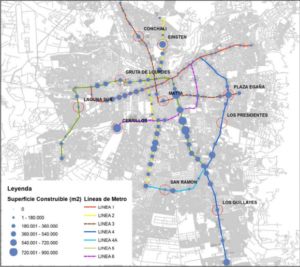
The willingness of local real estate developers to accept incentives to densify around Metro stations was studied. Two bonuses were issued to buyers: a developer bonus (for homes built in a limited period), regulatory releases (increased buildability and allowable density and decreased parking requirements), and state investment in public spaces for each development.
The estimated models were statistically adequate, with significant differences in the assessment of the incentives between different station types. The study found a low propensity on the part of the real estate agents to build in the sectors analyzed, but found a positive impact of the incentives investigated. The demand for social integration turned out to be a strong disincentive to construction in the different stations: the results show that in order to achieve the expected densification (with social integration), the level of incentives would have to be increased above those found in the study, a combination of a larger incentive or to not require explicit social integration, but to promote it indirectly.
As part of the study, the possible negative effects of an eventual densification process were analyzed. Although no major impacts are expected on the Metro operation, there are potential damages to the private transportation system due to cumulative effects of highly concentrated sets of real estate projects. Among the implementation considerations, it is important to emphasize the importance of densification measures being applied along with other mechanisms that protect their effects.
Project Cost Description
This project is a planning study and thus does not have explicit cost figures for implementation. However, this case is important for understanding the practicability of implementing Transit Oriented Development around metro stations.